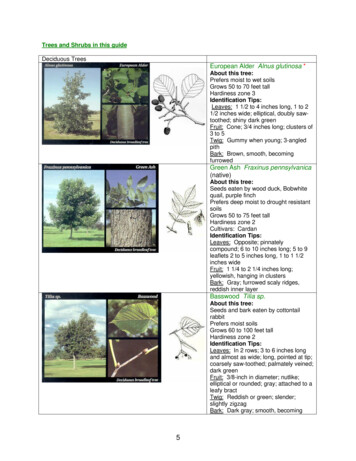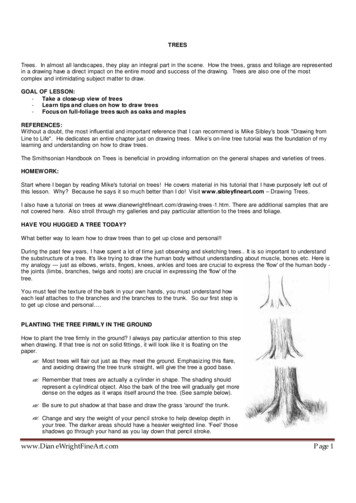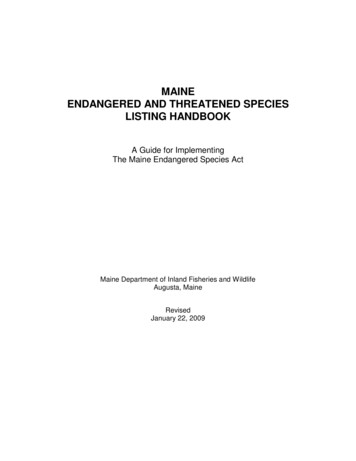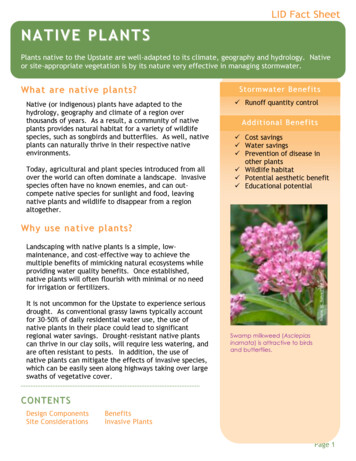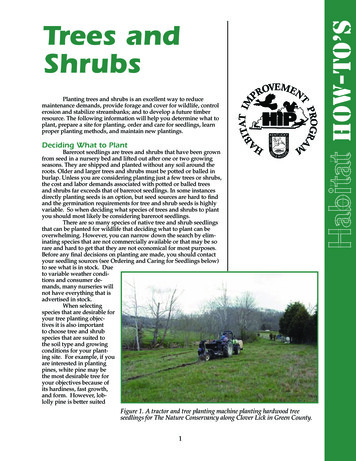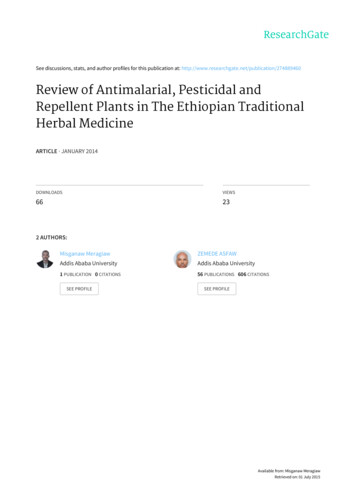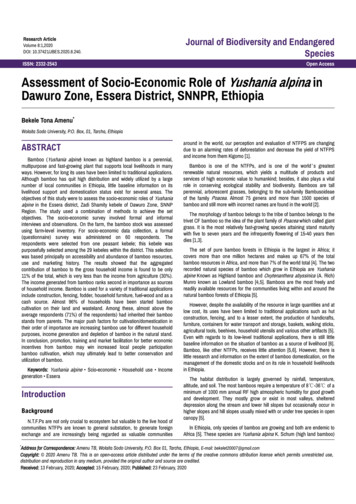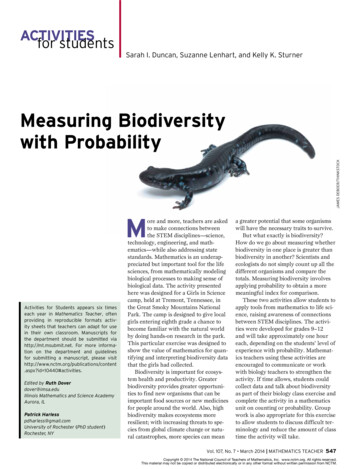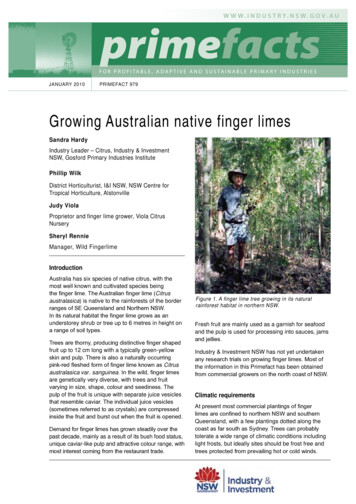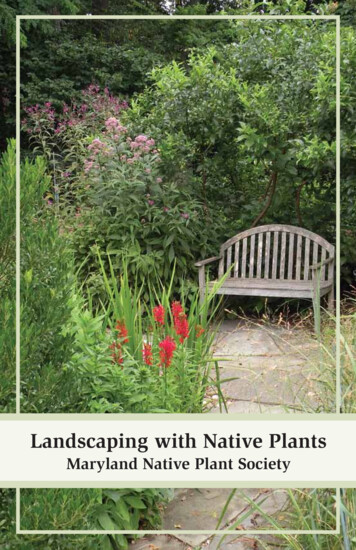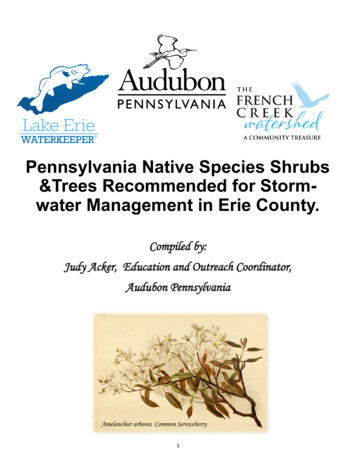
Transcription
Pennsylvania Native Species Shrubs&Trees Recommended for Stormwater Management in Erie County.Compiled by:Judy Acker, Education and Outreach Coordinator,Audubon PennsylvaniaAmelanchier arborea Common Serviceberry1
All plants marked with an BFAre available at:Beechwood Farms Nature ReserveAudubon Center for Native Plants614 Dorseyville Road,Fox Chapel Borough Pittsburgh, PA 15238Phone: 412-963-6100All plants marked with SAll plants marked with an EAre available at:Ernst Conservation Seeds9006 Mercer Pike Meadville, PA 16335800-673-3231 OR 814-336-2404(Sometimes plugs, potted and sometimes by seedsonly)All plants marked with a PCAre available at:Pampas Creek Perennials Nursery & Greenhouse6482 Galmish Road Cochranton, PA 16314814-425-3080Are available at:Stans Garden Center5001 Buffalo RoadErie, PA 16510Phone: 814-899-5424ORStans Garden Center5341 West Lake RoadErie, PA 16505814-835-6960All plants marked with JJWAre available at:JJ Wurst Landscape Contractors& Garden Center8334 Edinboro RoadErie, PA 16509814-476-7410All plants marked with FEAre available at:Fairview Evergreen Nurseries Inc.7463 W Ridge Rd,Fairview, PA 16415(814) 474-5712All plants marked with a JAre available from:Johnston’s Evergreen Nursery Inc.1000 Wales Road Erie, PA 16150814-739-2820All plants marked with LGAre available from:Locust Grove Nursery2308 Old State RoadWaterford, PA 16441814-796-3582All plants marked with a SYAre available from:Scotland Yards Greenhouse12555 Fry Rd Edinboro, PA 16412(814) 734-6700**REMEMBER plant lists change because of sales and other factorsso contact the Nurseries for availability.**PLEASE MAKE SURE BOTH LATIN NAMES ARE CORRECTBEFORE YOU BUY THE PLANT!2
Native PA Species Shrubs forStormwater Management in Erie County.Red Chokeberry-- Aronia arbutifolia / Photinia pyrifoliea—E, J , SNative habitat: swamps, bogs, moist woods. A colonial shrub species,grows from 3’ to 15’ tall, prefers full sun, low drought tolerance, bloomsfrom April to July, white flowers, produces pear shaped red fruit that persists into winter. Moist rich acidic soils. Fall foliage red to red orange.A source of wildlife cover and fall food.Black Chokeberry-- Aronia melanocarpa /Photina —E, JJW, SNative habitat: swamps, bogs, wet or dry woods. Shrub grows to 12’tall, somewhat shade tolerant, moderate drought tolerance, bloomsfrom March to June, white flowers produce black fruit that persists intowinter. Prefers part shade and moist acidic soils. Good source forwildlife cover and fall food.Kinnikinik/Silky Dogwood—Cornus amonmum— E, SNative habitat—Moist fields, meadows, swamps, moist woods PartShade to Shade in Clay, Loam, or Sandy soil. A shrub that growsto 10’ tall, moderate shade tolerance, low drought tolerance, bloomsfrom May to July with attractive white, greenish whitish or yellow flowers clusters in spring, produces blue and white fruit in the fall. Thethick low vegetation provides excellent habitat for a variety ofwild life and produces abundant fruit that is eaten by many birds.Red-osier Dogwood—Cornus sericea—E, J, FE, SNative Habitat: swamps, stream banks, moist fields, thickets Prefers part shade and moist, well drained soils but is adaptable to awide range of soil and climatic conditions. A multiple stemmed shrubgrows to 10’ tall, moderate shade tolerance, moderate drought tolerance, blooms from June to August, attractive clusters of white flowersproduce white fruit. Very conspicuous red branches in winter. Thethick low vegetation provides excellent habitat for a variety of wildlife,produces abundant fruit that provides fall and winter food for avariety of birds.3
Native PA Species Shrubs forStormwater Management in Erie County.Witch hazel-- Hamamelis virginiana—E, J, SY, SNative habitat: Rich rocky woods. A Multiple stemmed shrub withcrooked spreading branches with lettuce green leaves that turn brilliant gold in fall. Prefers rich, well-drained acid based soil. Barkis smooth and gray. Averages 10-15 ’ but can grow to 30’ tall, sunto moderate shade, low drought tolerance, blooms form September to November with strap like crumpled yellow flowers. Producessmall brown nuts in the fall which provide fall food for manyforms of wildlife, provides mid-story nesting habitat.Mountain Laurel—Kalmia latifolia—BF, FE, SPA State flower. Found in southern part of the watershed on dry tomoist acidic woods and slopes. A broadleaf evergreen, many-stemmed,thicket-forming shrub or sometimes a small tree with short, crookedtrunk; stout, spreading branches; a compact, rounded crown; and beautiful, large, bell-shaped, white to pink flowers with deep rose spots insidethat occur in flat-topped clusters. The leaves are oval, leathery, andglossy, and change from light-green to dark-green to purple throughoutthe year. Prefers part shade and cool, moist acidic rocky or sandysoils. All parts are highly toxic, Attract birds and larval host for Laurel Sphinx moth.Common Elderberry —Sambucus Canadensis—BF, E, SDeciduous, fast-growing, suckering shrub. Flat-topped, creamy whiteflower clusters in early summer followed by edible, deep purple berries.Height: 5-12'. Spread: to 12' or more. Part sun. Moist, average soil.Best used in informal garden situations and for naturalizing, especiallyat the wood or meadow edge. Prune back old or weak canes to trunknear the ground in winter every few years. Flowers provide nectar andbirds love the fruit. Rain garden plant.Red Berried Elder—Sambucus racemosa (Pubens)—BF, JJW, SDeciduous, fast-growing, suckering shrub. Flat-topped, creamy whiteflower clusters blooms earlier in spring and produces bright red fruits inearly summer. Height: 4-10'. Spread: 3-8' or more. Part sun. Moist,average soil. Best used in informal garden situations and for naturalizing, especially at the wood or meadow edge. Prune back old or weakcanes to trunk near the ground in winter every few years. **The stems,roots and foliage are poisonous or toxic. Flowers provide nectar andbirds love the fruit. Rain garden plant.4
Native PA Species TREES forStormwater Management in Erie County.Red Maple—Acer rubrum—J, E, FE, JJW, SFound in dry to moist woods, swamps and bogs A single stemmeddeciduous tree that grows from 60’ to 120’ tall, named for its often redautumn leaf display. Sun to shade tolerant, low drought tolerance,tolerant of most soils, but prefers slightly acid, moist conditions;blooms from March to May, red flowers, seed mature in spring. Limited use for maple syrup but provides food, browse and nestingsites for wildlife. Leaves and bark poisonous to livestock. Larvalhost to Cecropia Moth.Silver Maple—Acer saccharinum L—SY, SFound in moist woods, stream banks and alluvial soils. Prefers sun toshade with rich wet to moist acidic soils. A large deciduous treewith short, stout trunk, few large forks, spreading, open, irregularcrown of long, curving branches, and graceful deep cut-leaves with asilvery underside. Grows 75-100 ft. tall with a oval or rounded crown.Plump, red flower buds are visible in winter and the first to bloom inspring. Fall color ranges from yellow-brown to yellow tinged with brightred. Sugar can be obtained from the sweet sap but yield is low. Larvaland nectar source for Cecropia silkmoth.Sugar Maple—Acer saccharum— J, E, SY, JJW, SOften found in moist woods, wooded slopes, ravines, alluvial soils Asingle stemmed large tree, with rounded, dense crown and striking,multicolored foliage in autumn. Grows form 60’ to 100’ tall, preferssun but is shade tolerant, moderate drought tolerance, prefers rich,moist, well-drained soils, susceptible to salt, excessive heat, and leafscorch in drought. Blooms from February to June, yellow flowers,seeds mature in fall. Excellent source for maple syrup and timber,provides food and nesting sites for wildlife. Valuable to honeybees.5
Native PA Species TREES forStormwater Management in Erie County.Common Serviceberry—Amelanchier arborea—BF, PC,SY, LG, SAlso know as Shadbush, this deciduous small tree grows from 15-25 ft.and is often found on rocky bluffs and upper slopes. It prefers sun topart shade and dry well drained acidic soil. The white flowers occurin April and May in drooping clusters, appearing before the leaves.Young leaves are covered with soft, woolly hairs that disappear as theleaf matures. The plant’s ornamental bark is gray and smooth butstreaked with fissures; often with a reddish cast. Old bark is scaly. Small,edible berries are reddish-purple. The leaves may turn wine-red in fall.The names Shadbush allude to the fact that the showy masses of whiteflowers tend to occur at the same time that shad ascend the rivers inearly spring to spawn. This is the plant that is commonly sold in thenursery trade as Amelanchier canadensis. Attracts bees and birds.Hornbeam / Ironwood-- Carpinus caroliniana—E, SAlso known as Blue beech, Musclewood or Ironwood because of thevery hard wood. Found in rich moist woods and stream edges. Small,shrubby slow growing tree with one or more short trunks angled orfluted, long, slender, spreading branches, and broad, rounded crowngrowing to 40 ft. The graceful, drooping branches and slender trunkare pale gray, smooth and sinewy with twisting, muscle-like bulges.Shiny, bluish-green, deciduous leaves become scarlet-orange in thefall. The hanging fruit is papery in texture. Shade tolerant, lowdrought tolerance, moist, rich, deep acidic soils. Blooms in April.Provides food; seeds, buds and catkins for birds and wildlife.Larval Host: Eastern Tiger Swallowtail, Striped hairstreak, Redspotted Purple, Tiger swallow-tail.Shagbark Hickory-- Carya ovata—BF, SFound in low moist woods, stream banks, swamps, flood plains, and bottomland. Medium to large tree with height: to 70'. Width: to 35'. Blooms yellowgreen in spring. Produces thick shelled edible nuts and golden or bronzeleaves in fall. Distinctive, gray bark that peels in long, tough curls off thestraight trunk. Trunk typically narrow and straight with branching that beginshalf-way up. Full to part sun. Rich, moist soil, but adaptable. Must havegood drainage. Site carefully. Deep taproot makes transplanting of all butyoung seedlings impossible. Valuable for fuel and lumber. Butterfly andwildlife plant.6
Native PA Species TREES forStormwater Management in Erie County.Tulip Tree/Yellow Poplar-- Liriodendron tulipifera—J,SY, SA common tree in rich woods One of the tallest and most beautiful eastern hardwoods, with a long, straight trunk, a narrow crown that spreadswith age. Sun to shade. Rich moist, well drained soils. Grows upto150 ft. tall. Distinctive, star-shaped foliage. The leaves are waxy andsmooth, and turn bright gold in fall. Showy, yellow-orange, tulip-like flowers are often missed because they are up 50 ft. or higher in the tops oftrees. Cone-shaped seed heads remain after leaves have fallen. Pioneers hollowed out a single log to make a long, lightweight canoe. One ofthe chief commercial hardwoods, its used for furniture, as well as forcrates, toys, musical instruments, and pulpwood. This is a favoritenesting tree for birds and the flowers attract hummingbirds andbees. Larval Host: Eastern Tiger Swallowtail butterfly.Black Gum (Tupelo) — Nyssa sylvatica—J, SY, LG,SFound on dry to moist woods, rocky slopes and ridge tops. An attractive, variable-shaped deciduous tree, with many slender, nearly horizontal branches with a dense, conical or sometimes flat-topped crown andglossy waxy foliage turning scarlet in autumn. Grows 30-60 ft. in fullsun to shade in moist various acid based soil. Leafs out late. Goodfor a bog or water garden area. A bottle-shaped trunk forms if grown inshallow standing water. Deep roots allow for under-plantings of shrubsand wildflowers. Specimen or street tree. Berries are small and blueand consumed by many birds and mammals. Also a nectar plantfor bees. Protect from deer until well established and sizeable. Raingarden plant.Eastern White Pine-- Pinus strobus—BF, J, SY, FE, JJW, SFound in moist to dry woodlands and forested slopes. A stately canopytree, 75-100 ft. tall, Sun, part shade, shade. Prefers fertile welldrained dry to moist soils. Gracefully plume-like in outline, white pineis very distinctive when compared to other conifers. Tufts of light- tobluish-green long needles form feathery clusters of five only toward theends of the twigs. Cones are 6-8 in. long. The largest northeastern conifer, it is a magnificent evergreen tree with straight trunk and crown ofhorizontal branches, one row is added a year, becoming broad andirregular. Formerly the most valuable tree of the Northeast, EasternWhite Pine is used for construction, millwork, trim, and pulpwood. Attracts birds and mammals for food and shelter7
Native PA Species TREES forStormwater Management in Erie County.Sycamore—Platanus occidentalis—E, SFound near stream banks, low woods, and alluvial soils. A widecanopied, deciduous tree, 75-100 ft. tall, with a massive trunk and opencrown of huge, crooked branches. Grows in sun to shade in moist,sandy loams or silty clay soils. The bark of large, old trunks sloughsoff in scales or plates leaving a smooth, whitish inner bark making thetree look like camouflage material. Leaves are broad, blade often widerthan long, long pointed. Globular fruits often persist through December.Large, medium- to dark-green, maple-shaped leaves turn brown in fall.A shade tree, Sycamore grows to a larger trunk diameter than any othernative hardwood. The hollow trunks of old, giant trees were homesfor chimney swifts in earlier times. Attracts birds and is deer resistant.Quaking Aspen—Populus Tremuloides — JJW, SFound in old fields, open woods, or barrens. A 35-50 ft. deciduous treewith small, nearly round, shiny leaves which quiver in the slightestbreeze. Smooth, whitish-green bark becomes furrowed at the trunk’sbase with age. Silvery catkins appear before leaves. Fall color is brightyellow. Tolerates sun to shade in sandy, gravely limestone basedsoils. An early successional tree after fires, logging and on abandonedfields, it is short-lived and replaced by conifers. The twigs and foliageare browsed by many animals. Beavers, rabbits, and other mammalseat the bark, foliage, and buds, and grouse and quail feed on thewinter buds. .Wild Black Cherry-- Prunus serotina—EFound in woods, thickets, floodplains and fencerows. A multiplestemmed, easy and fast growing tree, it reaches heights to 80’ tall.When open-grown it becomes oval-headed with spreading, pendulouslimbs and arching branches. Crowded trees grow tall and slender.Drooping white flowers appear after the glossy leaves have emerged.Prefers full sun to part shade and neutral to acidic soils. Moderatedrought tolerance, blooms in May, white flowers produce purplish blackfruit in the fall. While the fruit is edible and used in beverages and cooking, the rest of the plant contains amygdalin and can be toxic if consumed. One of North Americas most valuable hardwoods. Providesfood, and nesting sites for wildlife. Fruit consumed by 33 speciesof birds and many mammals. Also attracts bees and butterflies.8
Native PA Species TREES forStormwater Management in Erie County.Northern White Oak—Quercus alba—E, FE, JJW, SA large tree with an irregular shaped, wide spreading crown, with lightgray bark that has shallow furrows forming scaly ridges. Twigs are grayto reddish-green; buds are reddish-brown and broadly oval and hairless. Catkins appear just before or with the appearance of new leaveswhich are 4 - 8 inches long with 5 - 9 lobes that are widest beyond middle with deep sinuses and broadly rounded lobes; dull or shiny grayishgreen above, light green beneath. Grows to 100’ tall, prefers sun buthas moderate shade tolerance, moderate drought tolerance, bloomsin mid spring. Can grow in dry to moist sites but prefers well draineddeep loam or sandy, acid based soils. The wood is used for furniture, flooring, and specialty items such as wine and whiskey barrels.The annual acorns provide food for many animals and birds. Attracts butterflies. Larval host to Edwards Hairstreak butterfly.Swamp White Oak—Quercus bicolor — J, E, JJW, SA large, wide, round-topped, deciduous tree found in low moist forests. Oneof the faster growing oaks, its leaves, with their silvery undersides, are typical of those of white oak, yet swamp white oak leaves lack deeply cut lobesand the distal half may have teeth. Tree grows to 100 feet with an irregularcrown. Bark is dark gray with deep furrows forming scaly or flat-ridges.Twigs are smooth, light brown; buds light orangish-brown, smooth, andblunt, leaves are glossy dark green above with white velvety hairs beneath.Fall leaf color is golden-brown to russet-red. Moderate shade tolerance,low drought tolerance, blooms in early spring, produces long egg shapedacorns annually. Prefers part shade and can thrive in poorly drained,heavy or fine loams or clay soils that are somewhat acidic. Swampwhite oak produces a hard wood that has been used for construction, cabinet making, boat building, railroad ties, and fencing. Attracts songbirds,ground birds, water birds and mammals.Pin Oak-- Quercus palustris—J, E, SY, FE, JJW, SFound in low moist wet woods, bottomlands and swamps. A popular,graceful lawn tree with regular compact form and fine-textured foliage,Pin Oak is hardy and easily transplanted because the shallow fibrousroot system lacks tap roots. Grows to 80’ tall, prefers full sun but willtolerate shade, low drought tolerance, blooms in spring, small acornsmature and drop early fall. One of the fastest growing oaks, it isstraight-trunked tree with spreading to horizontal branches, very slender pin-like twigs, and a broadly conical crown. Pin oak is a stronglypyramidal tree with a distinct central leader with a more graceful, slender appearance than most oaks. Dark-green foliage becomes darkred in fall. Leaves persist into winter. Will grow in heavy, poorlydrained soils but is intolerant of alkaline soils. Somewhat tolerantof city conditions, it is easily transplanted, and will tolerate urban conditions in areas well outside its natural range. Provides food andnesting sites for birds and woodland wildlife. Attracts birds,hummingbirds and butterflies. Larval host for the Gray Hairstreak butterfly.9
Native PA Species TREES forStormwater Management in Erie County.Northern Red Oak--Quercus rubra-E, SY, LG, FE, JJW, SA lowland forest tree, found in dry to moist sites A single stemmeddeciduous tree, grows to 100’ tall, moderate shade tolerance, moderate drought tolerance, blooms in mid spring, large acorns mature anddrop in early fall. Its straight trunk is clear of branches for some distance above the ground and supports a wide canopy. The dark bark isstriped with long, smooth plates separated by deep furrows. Leaf lobesare bristle-tipped. Fall color is can be crimson, golden-orange, or russet. Prefers sun to part shade in well drained loamy sand. Thenorthernmost eastern oak, it is the most important lumber species ofred oak—used for flooring, furniture, millwork, railroad cross-ties, minetimbers, fence posts, pilings, and pulpwood. A popular shade andstreet tree, with good form and dense foliage. One of the most rapidgrowing oaks, it transplants easily, is hardy in city conditions, and endures cold. Provides food and nesting sites for birds and woodland wildlife.Black Willow— Salix nigra—E , SFound in swamps, wet meadows, and along streams in rich alluvialsoils. A multiple stemmed, open crowned, tree, grows to 65’ tall, prefers full sun, in clay loam or sandy soils. Blooms from February toJune with inconspicuous flowers arranged in elongate clusters; maleand female flowers on separate trees. A fast-growing tree, with leafblades up to 5 inches long, narrow and tapering to an elongate tip, margins finely serrate. Bright yellow-green twigs bear yellow-green catkins.Seeds wind-borne on silky hairs. The bark is deeply furrowed. Livestakes have excellent rooting ability and produce fibrous roots. Leafdrops replenish organic life in streams and it provides wildlifehabitat and shade. This is the largest and most important willow withone of the most extensive ranges across the country.American Linden / Basswood—Tilia Americana—JJW, SRich woods. A stately, wide-spreading deciduous tree, 60-80 ft. tall.Conical in its younger form, the crown becomes rounded with age.Broadly oval leaves sometimes change to yellow in fall but often turnbrown and become somewhat unsightly. Flowers are inconspicuousbut fragrant. When flowering, the trees are full of bees and produces astrongly flavored honey. Tolerates sun to shade in moist, rich, welldrained, loamy soils. The soft, light wood is especially useful formaking food boxes, yardsticks, furniture, and pulpwood. Native Americans made ropes and woven mats from the tough fibrous inner bark.10
These Native PA Species TREES are also good for Stormwater Managementin Erie County but have no known local source:Latin NamePA Native HabitatCucumber TreeRich upland woods and slopes. A hardy, large, round-topped, deciduous tree. Grows 60-75 ft. tall andwide. Its leaves are 6-10 in. long, deep-green in summer and yellow-brown in fall. Flowers are not showy;only 2 in. across and greenish in color occurring at the top of the tree. They are followed by a cucumberlike fruit which turns from green to red.Tolerates sun to shade in rich moist to wet acidic soil.MagnoliaAcuminateEasternCottonwoodPopulus DeltoidsBigTooth AspenPopulusGrandidentataPitch PinePinus rigidaHop-hornbeamOstrya virginianaSSweet PignutHickoryCarya ovalisScarlet OakQuercus coccineaBlack OakQuercus velutinaFound on riverbanks, floodplains in rich alluvial soils. A large-canopied deciduous tree with upright limbsgrowing to100 ft. or more. Cattkins appear before leaf emergence. Large, papery, coarsely toothed, triangular, medium-green leaves turn yellow in fall. Pendulous clusters of flowers without petals in late Marchand early April. Seeds wind-borne on a tuft of cottony hairs—thus the name. A fast growing species thatis often short lived.Tolerates sun to shade in moist sandy, loamy or clay loam soils.Early successional woods and flood plains. A columnar tree 50-75 ft. tall. Toothed leaves are cottonywhite on the lower surface, especially when the tree is young. The slender trunk’s whitish bark, becomesfurrowed at base and darker gray with age. Silvery catkins appear before leaves. Deciduous foliage becomes golden-yellow in fall. Big Tooth Aspen is a pioneer tree after fires and logging and on abandonedfields, short-lived and replaced by conifers. The foliage, twig buds, and bark are consumed by wildlife.Prefers full sun and consistent moist, rich soils.Found only in the very southern part of Venango County, Pitch Pine is a small-to-medium-sized -at 40-70ft. -tree which matures at 8-12 years. It is an evergreen with an irregular, globular form; twisting, gnarled,drooping branches; and scaly, reddish-brown bark which eventually becomes black. It has stiff, yellowgreen needles, in clusters of three and cones occur in whorls of 3-5. This hardy species is resistant to fireand injury, forming sprouts from roots and stumps. Adapts to the driest, most unproductive sites andreadily sprouts back after disturbance. Attracts: squirrels, rabbits, deer, quail, pine warblers, pine grosbeaks, chickadees. Larval host for the Pine-devil Moth.Prefers Full Sun in Acidic Dry, rocky or sandy soil. (Intolerant of shade but salt tolerant.)Found on dry wooded slopes, often on soils high in calcium carbonate. Hop-hornbeam is a graceful, slowgrowing, understory deciduous tree with a trunk that looks like sinewy muscles and a rounded crown ofslender, spreading branches growing 30-50 ft. The loose bark, in narrow strips, covers the often twistingtrunk. Catkins bloom in April. Oval-pointed, mature leaves vary in size and turn a mild yellow in fall.Fruits are a hanging, hop-like structure. The common name refers to the resemblance of the fruit clustersto hops, an ingredient of beer. The nutlets and buds are eaten by bobwhites, pheasants, grouse, deer,and rabbits. It is not sensitive to drought but will not tolerate flooding. Notoriously sensitive to salt.Prefers full Sun to Part Shade on Dry to moist rich, well-drained soils.Found on rich dry woods and bluffs. The Pignut Hickory is a medium to medium-large deciduous treegrowing 50-80' tall, with a straight trunk and a broadly oblong crown. Young trees have relatively coarsegray bark with irregular furrows and ridges, while the bark of older trees is more shaggy. The upper leaflet surfaces are medium to dark green, hairless, and shiny, while the lower leaflet surfaces are dull olivegreen and usually hairless. Blooms from mid-to late spring for about 1-2 weeks. Sweet Pignut Hickoryoccurs primarily as scattered trees, rather than in colonies Treehoppers, Northern Walkingstick, Underwing Moths, Banded Hairstreak and Hickory Hairstreak butterflies, feed on the foliage and catkins.Prefers full or partial sun and fertile deep soil containing loam and organic material with wellbalanced moisture levels.Found on dry upland slopes and ridges in poor soil in a variety of habitats including mixed forests. Bestknown for its brilliant autumn color, the Scarlet Oak grows to 82ft by 49ft at a medium to rapid rate. It cantolerate strong winds but not maritime exposure. A popular and handsome shade and street tree, thelumber is marketed as Red Oak. It has shallowly lobed, dull green leaves, and acorns with a shallow cup.It begins to bear fruit at age 20 biennially. Bloom Time: March to May. Acorns provide food for squirrels,chipmunks, mice, deer, wild turkey, bluejays, and redheaded woodpeckers.Prefers moist soil, but also does well in poor, dry, sandy, or gravelly soils in semi-shade (lightwoodland) or no shade.A dominant forest tree, Black Oak is a deciduous tree found in upland woods on moist to dry soils. Itgrows 50-60 ft. high and the spread is variable. Large, spreading branches form an open crown that isoften quite irregular. Catkins appear just before or with the appearance of new leaves. Thick, glossy,pointed-lobed leaves often turn orange or red in fall. Blooms March to May. Water Use: Medium. Attracts:songbirds, ground birds, mammals, Butterflies and Hummingbirds. Easily distinguishable by the yellow ororange inner bark, formerly sources of tannin, of medicine, and of a yellow dye for cloth known as quercitron. The wood is used for flooring, boxcars, and cooperage.Prefers full Sun to part Shade in dry, sandy to moist, rich soils.11
12
sun to shade in moist various acid based soil. Leafs out late. Good for a bog or water garden area. A bottle-shaped trunk forms if grown in shallow standing water. Deep roots allow for under-plantings of shrubs and wildflowers. Specimen or street tree. Berries are small and blue and consumed
